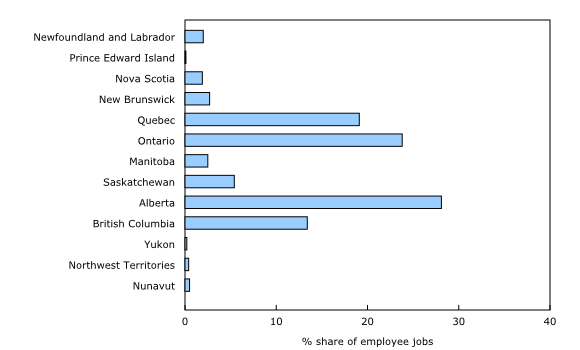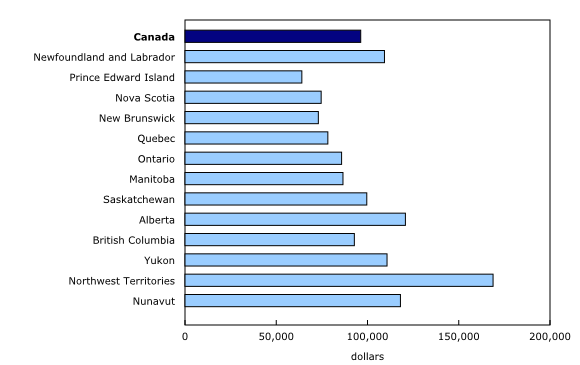Natural Resources Satellite Account: Human resource module, 2009 to 2019
Archived Content
Information identified as archived is provided for reference, research or recordkeeping purposes. It is not subject to the Government of Canada Web Standards and has not been altered or updated since it was archived. Please "contact us" to request a format other than those available.
Released: 2021-04-30
In 2019, the natural resource sector employed 652,581 people, representing 3.4% of all jobs. Of those, 637,373 (or 97.7%) were employee jobs, while the remainder were self-employment.
Nationally, the number of employee jobs in the natural resource sector totalled 637,373, with the greatest proportion of employee jobs in Alberta (28.1%), followed by Ontario (23.8%) and Quebec (19.1%).
Among the provinces and territories, jobs in the Northwest Territories ($168,801) had the highest average annual wages in 2019, followed by those in Alberta ($120,762) and Nunavut ($118,046). Jobs in Prince Edward Island ($64,030) and New Brunswick ($73,061) had the lowest annual wages, followed closely by those in Nova Scotia ($74,603).
While the economic and social landscape of Canada is very different at the time of this release than it was in 2019, these data provide a valuable baseline to better understand the potential impacts of COVID-19 in the following reference years.
More than a quarter of the jobs in the natural resource sector are held by women
Women held 27.5% of natural resource jobs in 2019. The number of jobs held by women was relatively unchanged from 2009 to 2019. In 2019, the largest share of women in jobs was in the hunting, fishing and water subsector (39.8%), followed by the energy subsector (31.1%). The lowest proportion of women in jobs was in the mineral and mining subsector (21.8%), followed closely by the forestry subsector (25.6%).
Close to two-thirds of workers have postsecondary diplomas
Almost two-thirds (64.6%) of natural resource workers had more than a high school education in 2019. The energy subsector had the most educated workers, with 69.0% of employees having more than a high school education and 52.3% of workers having a college diploma or university degree. The subsectors with the lowest share of employees with postsecondary education were forestry (56.1%), and hunting, fishing and water (57.3%).
Higher proportion of natural resource job holders aged 55 years and older
The workforce in the natural resource sector has been aging over time. In 2019, the proportion of employees aged 55 years and older stood at 23.6%, up from 16.3% in 2009.
Proportionally more visible minorities employed in the natural resource sector
Over the last decade, the workforce in the natural resource sector has become increasingly diverse. In 2019, 18.1% of the workforce identified as members of a visible minority group, up from 14.1% in 2009. The subsector with the largest percentage of visible minority employees was hunting, fishing and water (23.7%), while the mineral and mining subsector posted the lowest percentage (17.3%).
Increasing share of Indigenous and immigrant employees in natural resources
In 2019, 6.0% of natural resource employees identified as Indigenous, up from 4.4% in 2009. The subsector with the largest percentage of Indigenous employees was hunting, fishing and water (11.8%), while the energy sector (4.8%) recorded the lowest percentage.
Immigrant workers represented 24.5% of natural resource employees in 2019, up from 22.1% in 2009. Of which, the energy subsector had the largest number of immigrants (29.1%). In comparison, the downstream sector had proportionally more immigrant employees, at 38.5% in 2019.
Better paying jobs in the natural resource sector
In 2019, natural resource jobs paid an average of $96,280 per year, while the average Canadian job paid just over $56,783. Jobs in the energy subsector paid the highest annual wages and salaries, at $113,691 in 2019, while the lowest wages and salaries were in hunting, fishing and water, at $62,921
Jobs requiring a university degree had the highest compensation, reaching $129,173 in 2019. This was particular the case in the energy subsector, where jobs requiring a university degree paid over $148,054.
The gender wage gap closed slightly in the natural resource sector in 2019, with women earning an average annual salary of $86,120 compared with the average of $100,143 for men. In contrast, in 2009, the average salary for women was $67,066 compared with an average of $82,020 for men.
Immigrant employees ($103,742) in the natural resource sector had higher annual wages than non-immigrant employees ($93,867).
Note to readers
The aim of the Human Resource Module (HRM) is to provide timely and reliable statistics on the human resource dimension of natural resources production in Canada.
The Natural Resources Satellite Account already provides some information on the number of jobs generated by the sector at the national level. The HRM complements and enhances the analytical capacity provided by this product, allowing for a broader insight into the role of natural resources in the economy by providing more detailed human resource information.
The HRM provides annual estimates for the years from 2009 to 2019, including provincial and territorial estimates. These estimates are based on data from the Canadian Productivity Accounts, which are a key input to the HRM, as well as Labour Force Survey data. Census data for 2006 and 2016 as well as data from the 2011 National Household Survey are also incorporated.
The wages and salaries presented in this release do not include supplementary labour income and self-employment income.
Data tables are accessible upon request.
Products
Special tabulations are available upon request.
Additional information can be found in the articles, "The Natural Resources Satellite Account: Feasibility study" and "The Natural Resources Satellite Account – Sources and methods," which are part of the Income and Expenditure Accounts Technical Series (13-604-M).
Contact information
For more information, or to enquire about the concepts, methods or data quality of this release, contact us (toll-free 1-800-263-1136; 514-283-8300; STATCAN.infostats-infostats.STATCAN@canada.ca) or Media Relations (613-951-4636; STATCAN.mediahotline-ligneinfomedias.STATCAN@canada.ca).
- Date modified:



